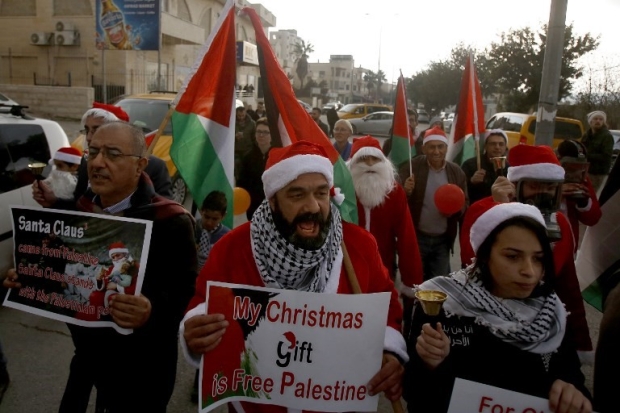In Bethlehem, I had a vivid experience of what Israel’s occupation feels like

"How still we see thee lie/Above thy deep and dreamless sleep/The silent stars go by," runs the famous Christmas carol sung all over the English-speaking world as it celebrates Christmas. On Christmas Eve midnight mass will sound out from Bethlehem's Church of the Nativity, the legendary birthplace of Jesus Christ, proclaiming he will bring "peace to men on earth".
The real Bethlehem
Nothing could be further from the truth than the image of a sweet, untroubled Bethlehem as depicted in a carol originally created by the pious imagination of a Victorian Western-Christian. Generations of Christian children have been brought up on it, and its mythical power is such that few of them realise what or even where Bethlehem is.
A well-educated English friend I had known for years was recently surprised to learn that Bethlehem was located in Palestine. In her mind the town was more a legend than an actual place, and connected to Jews, if to anyone.
The city I saw on a visit earlier this year was a travesty of the place the Christmas carol depicts
That idea is still widespread and has been instrumental in keeping Western-Christians disengaged from the real Bethlehem and unsupportive of its struggle for survival. The city I saw on a visit earlier this year was a travesty of the place the Christmas carol depicts and an indictment of Western Christianity's abject failure to sustain one of its holiest shrines.
In today's Bethlehem "dreamless sleep" is more like a nightmare, and the town can only "lie still" when Israel's occupation ends.
Israel's brutal vandalism
Bethlehem and its outlying villages of Beit Jala and Beit Sahour have been traditionally the most Christian of Palestine's places, even though Bethlehem has a Muslim majority now. Until Israel's occupation in 1967 the city had been an important social, cultural and economic hub, and one of Palestine's most ancient localities. Its name "Beit Lahem" goes back to Canaanite times, when it was a shrine to the Canaanite god, Lahm or Lahem.

Palestinians dressed as Santa Claus hold signs as they take part in a protest in the West Bank city of Bethlehem on 23 December, 2018 (AFP
Its architecture is testament to its rich history: Roman and Byzantine, when the Empress Helena had the Church of the Nativity built over the supposed cave of Jesus' birthplace in 327; followed by the Muslim conquests of 637, and then the crusader occupation from 1099 until ended by Saladin in 1187; the succeeding Ottomans built the city's walls in the early 16th century, their rule terminated by the British Mandate from 1922 to 1948.</span>
In 1995 Bethlehem was transferred to Palestinain Authority control, although it remains under Israel's overall rule.
Despite their variation, none of these preceding historical periods was ever associated with the brutal vandalism and destructiveness of Israel's current occupation
Despite their variation, none of these preceding historical periods was ever associated with the brutal vandalism and destructiveness of Israel's current occupation. Leaving Jerusalem southwards to travel the nine kilometre distance to Bethlehem, I took a wrong turn and found myself on a fast, modern highway without another Palestinain driver in sight.
I had stumbled by accident onto a Jews-only settler bypass road, one of two that skirt Bethlehem and connect with its encircling settlements. I soon realised the purpose of the operation: To pretend that no one else exists in the area but Jews.
A sad place
There are 22 Israeli settlements encircling Bethlehem, cutting off its exits and confiscating its agricultural land. They glower down from the surrounding hills and house more settlers than all of Bethlehem and its neighbourhoods. To the north is Har Homa, a settlement that until 2000 was an ancient, densely wooded hill called Jabal Abu Ghneim.
Israel uprooted the trees and replaced them with a colony of dreary, box-like houses, which it threatened to turn into a Bethlehem look-alike for tourists. Nokidim, to the east, is the current residence of Israel's hard-line former defence minister, Avigdor Lieberman.

Palestinians pray inside the Church of the Nativity as people gather for Christmas celebrations in the town of Bethlehem in the Israeli-occupied West Bank on 24 December 2017 (AFP)
Since 2015 Israel has closed off Bethlehem's fertile Cremisan Valley to its Palestinain owners, and announced in June of this year a massive settlement expansion along the route between Jerusalem and Bethlehem.
Rachels tomb, Bethlehems historic landmark on the main Jerusalem-Bethlehem road and an area traditionally buzzing with shops and restaurants, is now blocked off by the wall and reserved exclusively for Jews. Muslim worshippers who venerated the tomb (and built it) cannot go there. It is a sad place, deserted and lifeless. In the shadow of the wall most businesses have closed and as the noose tightens around Bethlehem, none will be left.
Bethlehem is deliberately isolated behind the formidable separation barrier, surrounded by checkpoints, and its economy strangulated
Israel's relentless penetration to the heart of Bethlehem is unmistakable. Bethlehem is deliberately isolated behind the formidable separation barrier, surrounded by checkpoints, and its economy strangulated. Its main source of prosperity had been tourism with two million annual visitors and a thriving souvenir market of classic olive wood and mother-of-pearl carvings.
It was also a rich agricultural area with a successful wine industry. But most of its land has been confiscated, and draconian restrictions on movement to and from Bethlehem have reduced tourism and pilgrim numbers drastically. Today its population of 220,00, including 20,000 refugees, have the highest unemployment rate in the occupied territories, second only to that of Gaza.
Saving Bethlehem
Sitting in the "cafe" outside the Walled Off Hotel at the entrance to Bethlehem, I had a vivid experience of what Israel's occupation feels like. The hotel is in effect a piece of installation art, created by the British artist, Banksy, to highlight the plight of Bethlehem.
The only view from the hotel windows is of Israel's hideous eight-metre wall, whose huge grey slabs are a mere car's width away.
READ MORE►
Stretching forward, you can almost touch it. I remember how its sinister watchtowers and surveillance cameras bore down on me oppressively. It was a scene out of a horror film.
To date, and despite church delegations, papal visits, and public expressions of concern, nothing Christians have done has halted or reversed Israel's destruction of a city so uniquely holy to Christendom. If they can do nothing to save Bethlehem, they can at least stop singing a carol that mocks its sad reality.
– Ghada Karmi is a Palestinian doctor, academic and author.
The views expressed in this article belong to the author and do not necessarily reflect the editorial policy of Middle East Eye.
Photo: A boy looks at Christ Child figurines displayed in a shop in the Biblical West Bank city of Bethlehem, on 22 December, 2018, three days ahead of the Christmas celebration (AFP)
[contf]
[contfnew]

middle east eye
[contfnewc]
[contfnewc]




